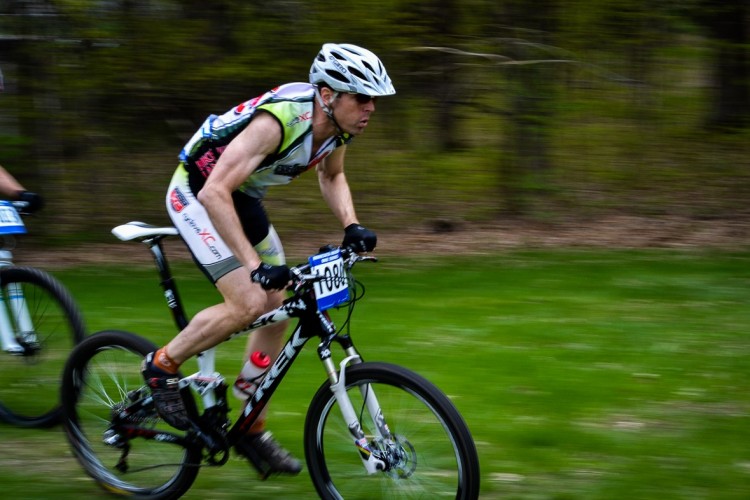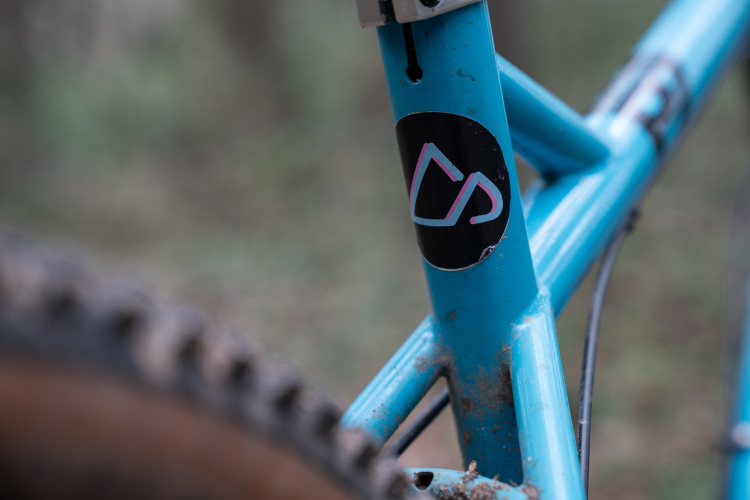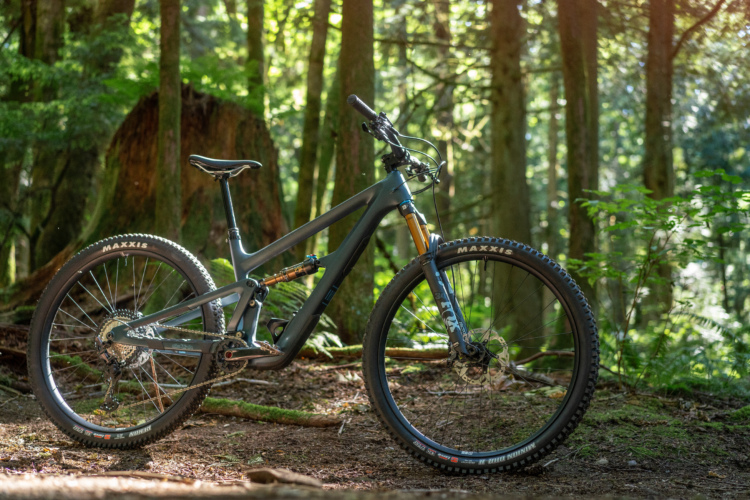
Pennsylvania is notorious for its technical riding. It’s hard to find a trail, much less an entire trail system, that isn’t riddled with rocks and roots. The Allegrippis Trails are different, boasting over 30 miles of flowy, smooth singletrack just a half hour away from Rothrock State Forest, some of the most technical riding that the Keystone State has to offer. For this reason, this stacked-loop system along the shores of Raystown Lake, just south of the small town of Huntingdon, has quickly become a gem for both locals and travelers, a world-renowned destination for people from as far away as Europe and Australia.
The Allegrippis Trails were also the site of Singlespeed USA this past August, causing some debate, as they are the complete opposite of representing typical Pennsylvania mountain biking. But there’s no doubt that they’re a blast to ride, and a new addition to the trail system has further increased the fun factor.
This past summer, a 5-acre mountain bike park opened up at the Seven Points Recreation Area, which houses an extensive campground, beach, marina, and other day-use facilities. The Allegrippis Trails surround and connect with Seven Points. The bike park has been a vision since the beginning of the plan for the Allegrippis Trail System, which opened in 2009, but there were a lot of holdups along the way.

The trails are located on federal Army Corps of Engineers (ACoE) land, but are leased to the Friends of Raystown Lake (FRL) through a very unique agreement (think: a leased area 5-feet-wide by 30-something miles). The FRL control the monetary aspect of maintaining the trails, but the Raystown Mountain Bicycling Association (RMBA) does all the actual maintenance. It’s a complicated system, and those complications also extend into the building and implementation of a new project, such as a bike park.
Three years ago, RMBA and the ACoE started seriously looking at how to finally make this project happen. Evan Gross, longtime president of RMBA and the driving force behind the Allegrippis Trails and mountain biking scene in the Huntingdon area, and Allen Gwinn, a ranger for the ACoE and head of the Army Corps of Engineers Handshake Partnership Program, have been partners since the Allegrippis Trails were simply a proposal from IMBA. Without either of them, the trails probably wouldn’t exist. These two were also the ones to start the process of making dreams of a bike park into a reality.
So, how does one go about building a bike park on federal lands? Everywhere is different, with a different set of challenges, but here’s the story behind the Raystown Mountain Bike Skills Park in PA.

Getting Approval
Trails are one thing. A bike park with built features that invite people to step outside of their comfort zones is another. In order to gain ACoE approval, the project needed to emphasize learning. This would not be a place that would only attract adrenaline junkies, hurling themselves off drops with abandon. This would be a place to allow riders of all skill levels to practice and try new things. It was likened to a playground. A playground is a place for kids to learn how to move their bodies around. A bike park is a place for people of all ages to experiment and grow as riders in a more safe, controlled environment that is easily-accessible and visible in case of an accident.
Despite the fact that the local ACoE was game for building the park, navigating the various channels for approval was a challenge, because there was no precedent in place for such a project at any ACoE facilities. The changing of ACoE District Commanders in the middle of the process didn’t help. It took nearly a year for the ACoE higher-ups to approve the project, but finally, they gave the green light, and the bike park was one step closer to implementation.

Funding
The next step was to find funding. Who was going to pay for materials, labor, and maintenance of a bike park? The ACoE didn’t have money in its budget to cover all of the expenses, but they were able to provide $35,000 through the Handshake Partnership Program, which is a way for the ACoE to provide seed money for natural resource conservation and recreation projects on federal ACoE land that partner with local organizations for the betterment of a community.
The Friends of Raystown Lake organization is a non-profit, which gives them access to grant money that would be unavailable to a federal government entity. So, technically, the bike park was built by the FRL, and then turned over to the ACoE for ownership upon completion, under an agreement similar to the one that governs the Allegrippis Trails–that the RMBA would be responsible for maintenance and upkeep through volunteer labor. The difference being that the ACoE would actually own the bike park once it was completed, rather than leasing it out, like the trails.
The FRL applied for grants and obtained $85,000 through the Allegheny Ridge Corporation, an organization that helps to provide funds for economic development, historic and environmental preservation, and outdoor recreation projects in Western and Central Pennsylvania. The FRL themselves were also able to come up with $15,000 to pitch in. The monetary aspect was covered.
Design and Building
Allen and Evan had a concept for the park, and the location they picked was perfect–just across the street from the area visitor center, in the middle of the campground at Seven Points Recreation Area, and on the way to the marina, beach, and pavilions. Now, someone needed to turn that vision into reality in the dirt.
Enter Dirtsculpt, a world-renowned company out of Bethlehem, PA, that has designed a variety of different bike parks, from small-town pump tracks to jump lines for the X Games and Red Bull events. Dave King, Dirtsculpt’s founder, came out to the site in 2015 to determine feasibility and begin the first stages of design. The 5-acre area that was currently a brushy, uneven field held lots of potential, and Dave was stoked.


Dirtsculpt came up with a preliminary design, which ended up changing a number of times throughout the building process. The final layout consisted of three different lines: beginner, intermediate, and advanced. The beginner line includes small berms, lots of rollers, and a wooden bridge with a 6-inch drop. The intermediate line features bigger berms, with larger rollers and jumps. The advanced line begins with two wooden jumps (one of which is off-camber directly into a berm), then leads into a whale tail, and ends with a series of larger table-top jumps. All the lines lead back to their beginnings for ease of use.
But before work could begin, there were a couple bureaucratic hangups that needed to be resolved. Despite the fact that there was already a builder lined up who had been to the site, designed a park, and was willing to do the job, the ACoE had to put the job out to bid. Because the park would be on federal land, not federal land that was actually leased to someone else, the job could not be sole-sourced. It’s simply a policy. And so, the process was held up as the job went out to bid, and the only takers were the builders who had originally planned to do it anyway. The holdup cost months, but finally, Dirtsculpt was approved to do their work.

That wasn’t the end of the bureaucratic hangups. The $35,000 provided for the project through the Army Corps Handshake Partnership Program could only be used for supplies, not labor. Making matters even more complicated, those supplies could only be bought from pre-approved places. So the ACoE couldn’t just go to the local lumber yard and grab materials. It’s another one of those “simply their policy” sorts of rules that might not make a lot of sense, but everybody needed to play by them. So, more time went by as the ACoE went about buying materials, such as lumber for decking and jumps, and wood for fenceposts.
Wet weather throughout the spring cost even more time, but slowly, the bike park began to take shape. Wooden features were built, and tons of dirt was moved with mini excavators and by hand to create berms and jumps. In addition to the countless hours put in by the three men from Dirtsculpt, volunteers from RMBA logged over 700 hours of work, doing everything from hauling dirt in wheelbarrows all day long to digging fence post holes and spreading grass seed and straw. A few very committed club members spent nearly all their free time on weekends and evenings helping out during the building process, while several official work days to put the final touches on the park saw a great turnout of locals willing to lend a hand.


Opening Day
After a number of setbacks, from government bureaucracy to a wet spring and many rained-out work days, the park finally opened to the public on July 2, 2016. It was a busy day at the lake, and people of all ages, abilities, and backgrounds stopped by to check out this new and interesting development. People attending a wedding reception at a nearby pavilion came over. Families from the campground brought their bikes down to try it out. Even people without bikes stood around and watched the scene for a while. Maybe a few were inspired to drag that old bike out of the basement, give it a tune-up, and take it for a spin.

Members of the RMBA, the volunteers who had worked hard to get the park ready for this day (myself included), had a little opening day party on the observation deck. We rode bikes, grilled dinner, and enjoyed a few beers in celebration of the fruits of all our labors.
With the encouragement of my friends, I was able to conquer some of my own fears. I started out the evening on the beginner line, as I don’t consider myself to be very good at jumping my bike, and slowly worked up to doing the intermediate line, and then the advanced line–something I thought it would take me months to have the courage to try. I skipped the whale tale, but I hit all the other jumps. It wasn’t necessarily graceful, but I didn’t crash, and I discovered that I was better than I thought at getting air (and ignoring the crowd of people watching me).
The Future
The Raystown Mountain Bike Skills Park is a unique non-pay-to-play addition to the diverse riding opportunities in Central PA, as well as the first project of its kind on ACoE land. The hope is that people in other places, and other ACoE facilities, will look at this as an example and begin to do similar things. It was a twisty, winding, rough road to get it done, but now the precedent is in place, and all parties agree that the hard work was worth it.

Locally, our mountain biking community hopes that the park will encourage an entirely new group of people to give riding a try. As one of several part-time gigs, I work in a restaurant, and a lot of my coworkers who might ride every now and then but aren’t super into it are now asking me all about the bike park. They’re excited. It’s something new for the area. The park occupies a prime time location right across from the visitor center at Raystown Lake. Every person who goes to the beach or camps or goes down to the marina to boat sees it. Kids see it, and realize that riding bikes is cool. The weekend warrior sees it, and decides it’s time to step up his game and hone his skills. Someone like me spends some time there and realizes that the advanced line is way more attainable than originally thought.
I’ve personally lived in and been a part of the mountain biking community in Huntingdon, PA for almost four years now, and it’s been a pleasure to watch it grow, even in the short time I’ve been around. The enthusiasm presented by the locals who are in love with the sport of mountain biking is truly inspiring. I watched my husband, friends, and fellow riders experience setback after setback while trying to turn this dream into a reality, but they kept pushing forward and now, this place is better for it.











1 Comments
Nov 23, 2016